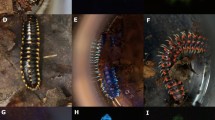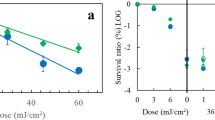Abstract
THE fact that riboflavin and eosin, which are known to determine the photo-inactivation of indoleacetic acid2,3, are both fluorescent, led us to investigate whether other fluorescent substances would also be effective in sensitizing such a reaction. Quinine sulphate, æsculin and 2,3,5-triphenyl tetrazolium chloride were tested. It was found by both chemical and biological experiments that these compounds were all active. These substances are colourless, but fluoresce with a visible colour, absorbing light in the ultra-violet region. They are not related chemically, fluorescence being apparently the only property common to them. The present experiments do not necessarily show that there is a direct cause-and-effect relationship between fluorescence and the capacity of inducing the photo-inactivation of indoleacetic acid.
This is a preview of subscription content, access via your institution
Access options
Subscribe to this journal
Receive 51 print issues and online access
$199.00 per year
only $3.90 per issue
Buy this article
- Purchase on Springer Link
- Instant access to full article PDF
Prices may be subject to local taxes which are calculated during checkout
Similar content being viewed by others
References
Boas, F., und Merkenschlager, F., Ber. deutsch. bot. Ges., 43 (1925).
Galston, A. W., Proc. U.S. Nat. Acad. Sci., 35 (1949).
Skoog, F., J. Cell. and Comp. Physiol., 7 (1935).
Author information
Authors and Affiliations
Rights and permissions
About this article
Cite this article
FERRI, M. Photo-inactivation of the Plant Hormone Indoleacetic Acid by Fluorescent Substances. Nature 168, 334–335 (1951). https://doi.org/10.1038/168334a0
Issue Date:
DOI: https://doi.org/10.1038/168334a0
Comments
By submitting a comment you agree to abide by our Terms and Community Guidelines. If you find something abusive or that does not comply with our terms or guidelines please flag it as inappropriate.



